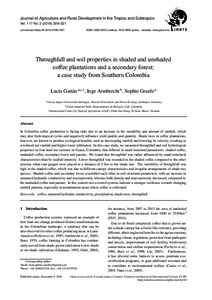Aufsatz

Throughfall and soil properties in shaded and unshaded coffee plantations and a secondary forest: a case study from Southern Colombia
Zusammenfassung
In Colombia coffee production is facing risks due to an increase in the variability and amount of rainfall, which may alter hydrological cycles and negatively influence yield quality and quantity. Shade trees in coffee plantations, however, are known to produce ecological benefits, such as intercepting rainfall and lowering its velocity, resulting in a reduced net-rainfall and higher water infiltration. In this case study, we measured throughfall and soil hydrological properties in four land use systems in Cauca, Colombia, that differed in stand structural parameters: shaded coffee, unshaded coffee, secondary forest and pasture. We found that throughfall was rather influenced by stand structural characteristics than by rainfall intensity. Lower throughfall was recorded in the shaded coffee compared to the other systems when rain gauges were placed at a distance of 1.0 m to the shade tree. The variability of throughfall was high in the shaded coffee, which was due to different canopy characteristics and irregular arrangements of shade tree species. Shaded coffee and secondary forest resembled each other in soil structural parameters, with an increase in saturated hydraulic conductivity and microporosity, whereas bulk density and macroporosity decreased, compared to the unshaded coffee and pasture. In this context tree-covered systems indicate a stronger resilience towards changing rainfall patterns, especially in mountainous areas where coffee is cultivated.
Zitierform
In: Journal of Agriculture and Rural Development in the Tropics and Subtropics. Kassel : Kassel University Press. - Vol. 117, No. 2 (2016), S. 309-321Sammlung(en)
Vol 117, No 2 (2016) (Journal of Agriculture and Rural Development in the Tropics and Subtropics (JARTS))Zitieren
@article{urn:nbn:de:hebis:34-2016101851061,
author={Gaitán, Lucía and Armbrecht, Inge and Graefe, Sophie},
title={Throughfall and soil properties in shaded and unshaded coffee plantations and a secondary forest: a case study from Southern Colombia},
year={2016}
}
0500 Oax 0501 Text $btxt$2rdacontent 0502 Computermedien $bc$2rdacarrier 1100 2016$n2016 1500 1/eng 2050 ##0##urn:nbn:de:hebis:34-2016101851061 3000 Gaitán, Lucía 3010 Armbrecht, Inge 3010 Graefe, Sophie 4000 Throughfall and soil properties in shaded and unshaded coffee plantations and a secondary forest: a case study from Southern Colombia / Gaitán, Lucía 4030 4060 Online-Ressource 4085 ##0##=u http://nbn-resolving.de/urn:nbn:de:hebis:34-2016101851061=x R 4204 \$dAufsatz 4170 7136 ##0##urn:nbn:de:hebis:34-2016101851061
<resource xsi:schemaLocation="http://datacite.org/schema/kernel-2.2 http://schema.datacite.org/meta/kernel-2.2/metadata.xsd"> 2016-12-15T08:02:42Z 2016-12-15T08:02:42Z 2016-12-09 1612-9830 2363-6033 urn:nbn:de:hebis:34-2016101851061 http://hdl.handle.net/123456789/2016101851061 eng Kassel University Press Urheberrechtlich geschützt https://rightsstatements.org/page/InC/1.0/ coffee saturated hydraulic conductivity precipitation shade trees throughfall 630 Throughfall and soil properties in shaded and unshaded coffee plantations and a secondary forest: a case study from Southern Colombia Aufsatz In Colombia coffee production is facing risks due to an increase in the variability and amount of rainfall, which may alter hydrological cycles and negatively influence yield quality and quantity. Shade trees in coffee plantations, however, are known to produce ecological benefits, such as intercepting rainfall and lowering its velocity, resulting in a reduced net-rainfall and higher water infiltration. In this case study, we measured throughfall and soil hydrological properties in four land use systems in Cauca, Colombia, that differed in stand structural parameters: shaded coffee, unshaded coffee, secondary forest and pasture. We found that throughfall was rather influenced by stand structural characteristics than by rainfall intensity. Lower throughfall was recorded in the shaded coffee compared to the other systems when rain gauges were placed at a distance of 1.0 m to the shade tree. The variability of throughfall was high in the shaded coffee, which was due to different canopy characteristics and irregular arrangements of shade tree species. Shaded coffee and secondary forest resembled each other in soil structural parameters, with an increase in saturated hydraulic conductivity and microporosity, whereas bulk density and macroporosity decreased, compared to the unshaded coffee and pasture. In this context tree-covered systems indicate a stronger resilience towards changing rainfall patterns, especially in mountainous areas where coffee is cultivated. open access In: Journal of Agriculture and Rural Development in the Tropics and Subtropics. Kassel : Kassel University Press. - Vol. 117, No. 2 (2016), S. 309-321 Gaitán, Lucía Armbrecht, Inge Graefe, Sophie Gedruckte Ausg. im Verlag Kassel Univ. Press (www.upress.uni-kassel.de) erschienen. </resource>
Die folgenden Lizenzbestimmungen sind mit dieser Ressource verbunden:
Urheberrechtlich geschützt

